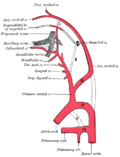| Infraorbital artery | |
|---|---|
 Plan of branches of internal maxillary artery. (Infraorbital at far right.) | |
 Left orbicularis oculi, seen from behind. (Infraorbital labeled at lower left.) | |
| Details | |
| Source | Maxillary artery |
| Branches | Orbital branches anterior superior alveolar arteries |
| Identifiers | |
| Latin | arteria infraorbitalis |
| TA98 | A12.2.05.078 |
| TA2 | 4447 |
| FMA | 49767 |
| Anatomical terminology | |
The infraorbital artery is a small [1] artery in the head that arises from the maxillary artery and passes through the inferior orbital fissure to enter the orbit, then passes forward along the floor of the orbit, finally exiting the orbit through the infraorbital foramen to reach the face.


